Take A Road Trip Through Time With Landsat 9
Take a Road Trip through Time with Landsat 9
A lot can change in five decades! How we talk, what we wear – it all evolves. But one thing that’s stayed consistent is our unique view of our home planet from above. Five decades ago, we at NASA partnered with United States Geological Survey (USGS) to launch a satellite called Landsat to see Earth from space. Now, we’re launching Landsat 9 – that’s right, the ninth in the series!

Join us for a road trip through the decades from the idea of an Earth-imaging satellite in the groovy 60s to the launch of Landsat 9 this year. Hop in!

The 60s
Far out! In 1966, USGS proposed a satellite to image land all around our planet. Researchers worked with our scientists and engineers to design the satellite and figure out how it would work.

The 70s
Here’s the lowdown: In 1970, we got approval to build the Earth Resources Technology Satellite, later renamed Landsat 1. The satellite launched in 1972 and provided the first digital data of Earth, repeated at regular intervals, which allows us to see changes as they happen.

The 80s
In 1982, we launched Landsat 4, followed by Landsat 5 in 1984. These two satellites collected more wavelengths of light at higher precision, allowing for natural color images, which is totally radical, dude.

The 90s
Wasssup, 1990s? Landsat 7 launched this decade, collecting even more data than previous Landsat satellites, enough to produce the first hi-res natural color map of remote Antarctica.

The 2000s
In 2008, our partners at USGS made all Landsat data available for free. This gave peeps around the world access to all the data they needed, unlocking innovation and creating economic benefits, like the ability to track crop health from space. Sweet!

The 2010s
In 2013, Landsat 8 began the modern era of Landsat observations. A new style of sensor and ground system made it possible to download much more and better data than ever before. Plus, a partnership with European Space Agency’s Sentinel-2 satellites gives even more regular observations. We heart that!

The 2020s
Now, we’re set to launch Landsat 9, a twin to Landsat 8. Two Landsat satellites with two instruments each will highkey change our view of Earth once again.

Now, on to the next 50 years of Earth observations! Stay tuned to watch Landsat 9 launch and start telling us even more about our home planet.
Make sure to follow us on Tumblr for your regular dose of space.
More Posts from Nasa and Others

What’s It Like to Work in NASA’s Mission Control Center?
In the latest installment of our First Woman graphic novel series, we see Commander Callie Rodriguez embark on the next phase of her trailblazing journey, as she leaves the Moon to take the helm at Mission Control.

Flight directors work in Mission Control to oversee operations of the International Space Station and Artemis missions to the Moon. They have a unique, overarching perspective focused on integration between all the systems that make a mission a success – flight directors have to learn a little about a lot.
Diane Dailey and Chloe Mehring were selected as flight directors in 2021. They’ll be taking your questions about what it’s like to lead teams of flight controllers, engineers, and countless professionals, both agencywide and internationally, in an Answer Time session on Nov. 28, 2023, from noon to 1 p.m. EST (9-10 a.m. PST) here on our Tumblr!
Like Callie, how did their unique backgrounds and previous experience, prepare them for this role? What are they excited about as we return to the Moon?
🚨 Ask your questions now by visiting https://nasa.tumblr.com/ask.
Diane Dailey started her career at NASA in 2006 in the space station Environmental Control and Life Support Systems (ECLSS) group. As an ECLSS flight controller, she logged more than 1,700 hours of console time, supported 10 space shuttle missions, and led the ECLSS team. She transitioned to the Integration and System Engineering (ISE) group, where she was the lead flight controller for the 10th and 21st Commercial Resupply Services missions for SpaceX. In addition, she was the ISE lead for NASA’s SpaceX Demo-1 and Demo-2 crew spacecraft test flights. Dailey was also a capsule communicator (Capcom) controller and instructor.
She was selected as a flight director in 2021 and chose her call sign of “Horizon Flight” during her first shift in November of that year. She has since served as the Lead Flight director for the ISS Expedition 68, led the development of a contingency spacewalk, and led a spacewalk in June to install a new solar array on the space station. She is currently working on development of the upcoming Artemis II mission and the Human Lander Systems which will return humanity to the moon. Dailey was raised in Lubbock, Texas, and graduated from Texas A&M University in College Station with a bachelor’s degree in biomedical engineering. She is married and a mother of two. She enjoys cooking, traveling, and spending time outdoors.
Chloe Mehring started her NASA career in 2008 in the Flight Operations’ propulsion systems group and supported 11 space shuttle missions. She served as propulsion support officer for Exploration Flight Test-1, the first test flight of the Orion spacecraft that will be used for Artemis missions to the Moon. Mehring was also a lead NASA propulsion officer for SpaceX’s Crew Dragon spacecraft and served as backup lead for the Boeing Starliner spacecraft. She was accepted into the 2021 Flight Director class and worked her first shift in February 2022, taking on the call sign “Lion Flight”. Since becoming certified, she has worked over 100 shifts, lead the NG-17 cargo resupply mission team, and executed two United States spacewalks within 10 days of each other. She became certified as a Boeing Starliner Flight Director, sat console for the unmanned test flight in May 2022 (OFT-2) and will be leading the undock team for the first crewed mission on Starliner in the spring of next year. She originally is from Mifflinville, Pennsylvania, and graduated with a bachelor’s degree in aerospace engineering from The Pennsylvania State University in State College. She is a wife, a mom to one boy, and she enjoys fitness, cooking and gardening.
Chemical Space Gardens
You know that colorful crystal garden you grew as a kid?
Yeah, we do that in space now.
Chemical Gardens, a new investigation aboard the International Space Station takes a classic science experiment to space with the hope of improving our understanding of gravity’s impact on their structural formation.

Here on Earth, chemical gardens are most often used to teach students about things like chemical reactions.

Chemical gardens form when dissolvable metal salts are placed in an aqueous solution containing anions such as silicate, borate, phosphate, or carbonate.

Delivered to the space station aboard SpaceX’S CRS-15 cargo mission, the samples for this experiment will be processed by crew members and grown throughout Expedition 56 before returning to Earth.

Results from this investigation could provide a better understanding of cement science and improvements to biomaterial devices used for scaffolding, for use both in space and on Earth.
Follow the growth of the chemical garden and the hundreds of other investigations constantly orbiting above you by following @ISS_Research on Twitter.
Make sure to follow us on Tumblr for your regular dose of space: http://nasa.tumblr.com
hi! i hope you're doing well. i wanted to ask, how do you land a job at nasa?
thanks!
Send Your Name to Jupiter
You’re invited to sign your name to a poem written by the U.S. Poet Laureate, Ada Limón. The poem connects two water worlds — Earth, yearning to reach out and understand what makes a world habitable, and Europa, waiting with secrets yet to be explored.
The poem will be engraved on Europa Clipper, along with participants' names that will be physically etched onto microchips mounted on the spacecraft. Together, the poem and names will travel 1.8 billion miles to the Jupiter system.

Signing up is easy! Just go to this site to sign your name to the poem and get on board. We also have a Spanish-language site where you can send your name en español: Envía tu nombre aquí.
The Europa Clipper launch window opens in October 2024, but don’t wait – everyone’s names need to be received by December 31 this year so they can be loaded onto the spacecraft in time. We hope you’ll be riding along with us! Follow the mission at europa.nasa.gov.
Make sure to follow us on Tumblr for your regular dose of space!
Happy 4th of July… From Space!
In Hollywood blockbusters, explosions and eruptions are often among the stars of the show. In space, explosions, eruptions and twinkling of actual stars are a focus for scientists who hope to better understand their births, lives, deaths and how they interact with their surroundings. Spend some of your Fourth of July taking a look at these celestial phenomenon:

Credit: NASA/Chandra X-ray Observatory
An Astral Exhibition
This object became a sensation in the astronomical community when a team of researchers pointed at it with our Chandra X-ray Observatory telescope in 1901, noting that it suddenly appeared as one of the brightest stars in the sky for a few days, before gradually fading away in brightness. Today, astronomers cite it as an example of a “classical nova,” an outburst produced by a thermonuclear explosion on the surface of a white dwarf star, the dense remnant of a Sun-like star.

Credit: NASA/Hubble Space Telescope
A Twinkling Tapestry
The brilliant tapestry of young stars flaring to life resemble a glittering fireworks display. The sparkling centerpiece is a giant cluster of about 3,000 stars called Westerlund 2, named for Swedish astronomer Bengt Westerlund who discovered the grouping in the 1960s. The cluster resides in a raucous stellar breeding ground located 20,000 light-years away from Earth in the constellation Carina.
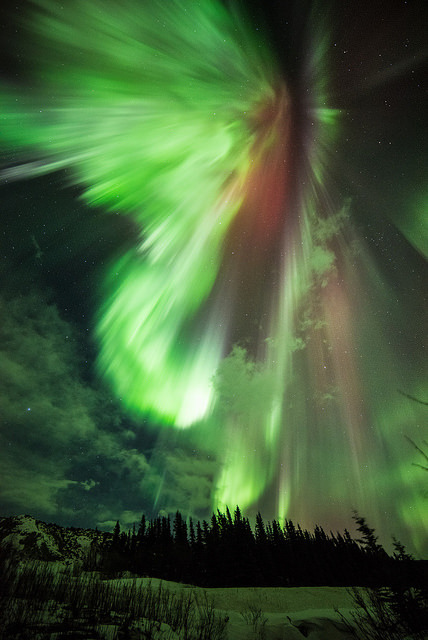
Credit: NASA/THEMIS/Sebastian Saarloos
An Illuminating Aurora
Sometimes during solar magnetic events, solar explosions hurl clouds of magnetized particles into space. Traveling more than a million miles per hour, these coronal mass ejections, or CMEs, made up of hot material called plasma take up to three days to reach Earth. Spacecraft and satellites in the path of CMEs can experience glitches as these plasma clouds pass by. In near-Earth space, magnetic reconnection incites explosions of energy driving charged solar particles to collide with atoms in Earth’s upper atmosphere. We see these collisions near Earth’s polar regions as the aurora. Three spacecraft from our Time History of Events and Macroscale Interactions during Substorms (THEMIS) mission, observed these outbursts known as substorms.

Credit: NASA/Hubble Space Telescope//ESA/STScI
A Shining Supermassive Merger
Every galaxy has a black hole at its center. Usually they are quiet, without gas accretions, like the one in our Milky Way. But if a star creeps too close to the black hole, the gravitational tides can rip away the star’s gaseous matter. Like water spinning around a drain, the gas swirls into a disk around the black hole at such speeds that it heats to millions of degrees. As an inner ring of gas spins into the black hole, gas particles shoot outward from the black hole’s polar regions. Like bullets shot from a rifle, they zoom through the jets at velocities close to the speed of light. Astronomers using our Hubble Space Telescope observed correlations between supermassive black holes and an event similar to tidal disruption, pictured above in the Centaurus A galaxy.

Credit: NASA/Hubble Space Telescope/ESA
A Stellar Explosion
Supernovae can occur one of two ways. The first occurs when a white dwarf—the remains of a dead star—passes so close to a living star that its matter leaks into the white dwarf. This causes a catastrophic explosion. However most people understand supernovae as the death of a massive star. When the star runs out of fuel toward the end of its life, the gravity at its heart sucks the surrounding mass into its center. At the turn of the 19th century, the binary star system Eta Carinae was faint and undistinguished. Our Hubble Telescope captured this image of Eta Carinae, binary star system. The larger of the two stars in the Eta Carinae system is a huge and unstable star that is nearing the end of its life, and the event that the 19th century astronomers observed was a stellar near-death experience. Scientists call these outbursts supernova impostor events, because they appear similar to supernovae but stop just short of destroying their star.

Credit: NASA/GSFC/SDO
An Eye-Catching Eruption
Extremely energetic objects permeate the universe. But close to home, the Sun produces its own dazzling lightshow, producing the largest explosions in our solar system and driving powerful solar storms.. When solar activity contorts and realigns the Sun’s magnetic fields, vast amounts of energy can be driven into space. This phenomenon can create a sudden flash of light—a solar flare.The above picture features a filament eruption on the Sun, accompanied by solar flares captured by our Solar Dynamics Observatory.
Make sure to follow us on Tumblr for your regular dose of space: http://nasa.tumblr.com
Hello! I am an avid lover of the cosmos and all things too grand for our minds to grasp. I was wondering, honestly, how do you cope with the pressure of your jobs, or say the scale of what is on your shoulders? It's quite an impressive thing you do, and it just gets me curious as to how you deal with the expectations that come with this type of job? Like, when you go home at night and eat your dinner, go to bed, do you have to practice mindfulness? Thanks for answering these! Love you guys!!!
Crab Nebula in technicolor! This new composite view combines data from five different telescopes, showing the celestial object in multiple kinds of light.
The video starts with a composite image of the Crab Nebula, a supernova remnant that was assembled by combining data from five telescopes spanning nearly the entire breadth of the electromagnetic spectrum: the Very Large Array, the Spitzer Space Telescope, the Hubble Space Telescope, the XMM-Newton Observatory, and the Chandra X-ray Observatory.
It then dissolves to the red-colored radio-light view that shows how a neutron star’s fierce “wind” of charged particles from the central neutron star energized the nebula, causing it to emit the radio waves.
The yellow-colored infrared image includes the glow of dust particles absorbing ultraviolet and visible light.
The green-colored Hubble visible-light image offers a very sharp view of hot filamentary structures that permeate this nebula.
The blue-colored ultraviolet image and the purple-colored X-ray image shows the effect of an energetic cloud of electrons driven by a rapidly rotating neutron star at the center of the nebula.
Make sure to follow us on Tumblr for your regular dose of space: http://nasa.tumblr.com
How will Cygnus Spacecraft Dock to Space Station?
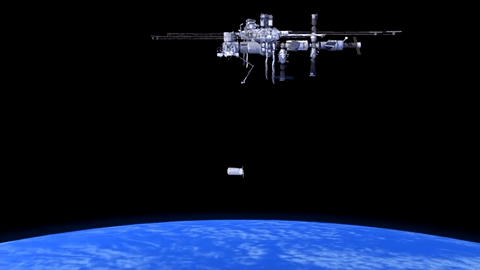
Orbital ATK’s Cygnus CRS-6 spacecraft launched to the International Space Station on March 22.
Cygnus will carry almost 7,500 pounds of science and research, crew supplies and vehicle hardware to the orbiting laboratory.
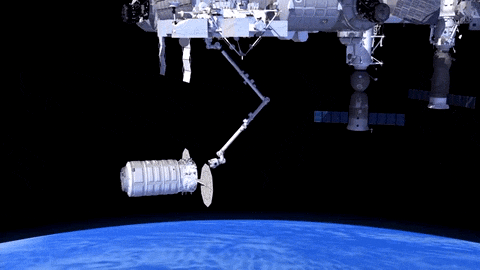
After launch in Florida, the spacecraft will arrive to the station on Saturday, March 26. Upon arrival, NASA astronaut and Expedition 46 Commander Tim Kopra will capture Cygnus at about 6:40 a.m. using the space station's Canadarm2 robotic arm to take hold of the spacecraft. Astronaut Tim Peake of ESA (European Space Agency) will support Kopra in a backup position.
Installation (when Cygnus is connected to space station) is expected to begin at 9:25 a.m. NASA TV coverage for installation resumes at 9:15 a.m.
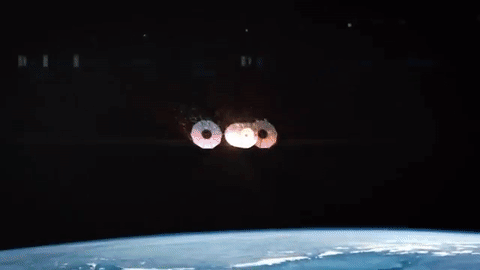
After the Cygnus spacecraft is berthed (connected) to the space station, the contents will be emptied and brought inside for use. Any trash that is on the space station, can be put inside the empty Cygnus before it is undocked from station and sent to burn up in Earth’s atmosphere.
Watch Capture
You can watch the capture of Orbital ATK’s Cygnus spacecraft online. Stream live coverage starting at 5:30 a.m. EDT on Saturday, March 26. Capture is scheduled for 6:40 a.m.
Tune in again at 9:15 a.m. to watch #Cygnus installation to the station.
Watch online: nasa.gov/nasatv
Make sure to follow us on Tumblr for your regular dose of space: http://nasa.tumblr.com
Chart-Topping Space Images From 2019 You Won’t Want to Miss
From the first-ever image of a black hole, to astronaut Christina Koch breaking the record for the longest single spaceflight by a woman – 2019 was full of awe-inspiring events!
As we look forward to a new decade, we’ve taken ten of our top Instagram posts and put them here for your viewing pleasure. With eight out of ten being carousels, be sure to click on each title to navigate to the full post.
1. First-Ever Black Hole Image Makes History

In a historic feat by the Event horizon Telescope and National Science Foundation, an image of a black hole and its shadow was captured for the first time. At a whopping 3.4 million likes, this image takes home the gold as our most loved photo of 2019. Several of our missions were part of a large effort to observe this black hole using different wavelengths of light and collect data to understand its environment. Here’s a look at our Chandra X-Ray Observatory’s close-up of the core of the M87 galaxy with the imaged black hole at its center.
2. Hubble Celebrates 29 Years of Dazzling Discoveries


When you wish upon a star… Hubble captures it from afar ✨On April 18, 2019 our Hubble Space Telescope celebrated 29 years of dazzling discoveries, serving as a window to the wonders of worlds light-years away.
Hubble continues to observe the universe in near-ultraviolet, visible, and near-infrared light. Over the past 29 years, it has captured the farthest views ever taken of the evolving universe, found planet-forming disks around nearby stars and identified the first supermassive black hole in the heart of a neighboring galaxy. Want more? Enjoy the full 10 photo Instagram carousel here.
3. Stars and Stripes in Space for Flag Day


Patriotism was in the air June 14 for Flag Day, and coming in at number three in our most liked Instagram line up is a carousel of our stars and stripes in space! One of the most iconic images from the Apollo 11 missions is of Buzz Aldrin saluting the American flag on the surface of the Moon. But did you know that over the years, five more flags joined the one left by Apollo 11 – and that many other flags have flown onboard our spacecraft? Scroll through the full carousel for flag day here.
4. Spitzer Celebrates its Super Sweet 16!


Since 2003, our Spitzer Space Telescope has been lifting the veil on the wonders of the cosmos, from our own solar system to faraway galaxies, using infrared light! Thanks to Spitzer, we've confirm the presence of seven rocky, Earth-size planets, received weather maps of hot, gaseous exoplanets and discovered a hidden ring around Saturn. In honor of Spitzer's Sweet 16 in space, enjoy 16 jaw-dropping images from its mission here.
5. Earth as Seen Through Our Astronauts’ Eyes Show Perspective Changing Views

“That's here. That's home. That's us.” – Carl Sagan
Seeing Earth from space can alter an astronauts’ cosmic perspective, a mental shift known as the “Overview Effect.” First coined by space writer Frank White in 1987, the Overview Effect is described as a feeling of awe for our home planet and a sense of responsibility for taking care of it. See Earth from the vantage point of our astronauts in a carousel of perspective-changing views here.
6. Astronaut Christina Koch Breaks Record for Longest Single Spaceflight by Woman


Astronaut Christina Koch (@Astro_Christina) set a record Dec. 28, 2019 for the longest single spaceflight by a woman, eclipsing the former record of 288 days set by Peggy Whitson. Her long-duration mission is helping us learn how to keep astronauts healthy for deep space exploration to the Moon and Mars. Congrats to Christina on reaching new heights! Join in the celebration and view few photos she captured from her vantage point aboard the Space Station here.
7. Our Beautiful Planet – The Only Place We Know to Harbor Life – From Space


Earth is special. It’s the only place in the universe that we know contains life.
On July 7, 2019, two million people joined us in celebrating its beauty with a jaw dropping carousel of our home planet, as captured by crew members aboard the International Space Station. Bright blue oceans, glowing city lights and ice-capped mountain peaks come to life in a collection of breathtaking images, found here.
8. A Moon Even Sinatra Couldn’t Help But Sing About

Every 29 days our Moon turns over a new leaf, and on May, 18 we saw a very special one of its faces. Appearing opposite the Sun at 5:11 p.m. EDT, the world looked up to find a Blue Moon! Though the Moon didn’t actually look blue, the site of one is kind of rare. They occur on average about every two-and-a-half years when a season ends up having four full moons instead of three. Click through a carousel of high-definition lunar phases here.
9. The Majesty of Hubble Imagery ... From Your Backyard


On December 23, a new gallery of Hubble Space Telescope images highlighting celestial objects visible to amateur and professional astronomers alike was released. All of the objects are from a collection known as the Caldwell catalog, which includes 109 interesting objects visible in amateur-sized telescopes in both the northern and southern skies. Flip through the jaw-dropping carousel here, and learn more about how you can study the night sky with Hubble here.
10. The Moon Gets Sassy

Nobody:
The Moon: “Y'all on the way yet?” 👀
We're working on it, Moon. Under the Artemis program, we're sending the first woman and the next man to walk on your surface by 2024. Find out how we’re doing it here.

For more pictures like these, follow us on Instagram: https://www.instagram.com/nasa/
Make sure to follow us on Tumblr for your regular dose of space: http://nasa.tumblr.com
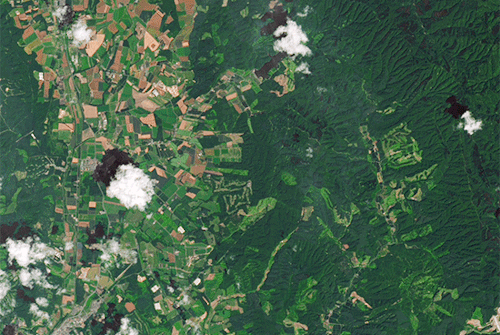
Landslides in Japan
On Sept. 6, 2018, shortly after the remnants of Typhoon Jebi drenched southern Hokkaido, a powerful earthquake rattled the Japanese island. The 6.6-magnitude quake shook the surface enough to unleash hundreds of landslides.
The Landsat 8 satellite acquired imagery of the widespread damage. An image acquired on Sept. 15, 2018, shows mud and debris in a hilly area east of Abira. For comparison, the previous image shows the same area on July 26, 2017.
Read more about this
Make sure to follow us on Tumblr for your regular dose of space: http://nasa.tumblr.com.
-
 pza01 liked this · 9 months ago
pza01 liked this · 9 months ago -
 jellyloveru reblogged this · 2 years ago
jellyloveru reblogged this · 2 years ago -
 jellyloveru liked this · 2 years ago
jellyloveru liked this · 2 years ago -
 arco-irisi reblogged this · 2 years ago
arco-irisi reblogged this · 2 years ago -
 arco-irisi liked this · 2 years ago
arco-irisi liked this · 2 years ago -
 appla1 reblogged this · 3 years ago
appla1 reblogged this · 3 years ago -
 delllenasstuff liked this · 3 years ago
delllenasstuff liked this · 3 years ago -
 bloggoodtimes reblogged this · 3 years ago
bloggoodtimes reblogged this · 3 years ago -
 stardustwolken liked this · 3 years ago
stardustwolken liked this · 3 years ago -
 enby-astronaut liked this · 3 years ago
enby-astronaut liked this · 3 years ago -
 skunkkkkkkk reblogged this · 3 years ago
skunkkkkkkk reblogged this · 3 years ago -
 jfizkavevenzkjejfbevevehjd liked this · 3 years ago
jfizkavevenzkjejfbevevehjd liked this · 3 years ago -
 technologistsinsync reblogged this · 3 years ago
technologistsinsync reblogged this · 3 years ago -
 cakeandcloth reblogged this · 3 years ago
cakeandcloth reblogged this · 3 years ago -
 gayforkiko liked this · 3 years ago
gayforkiko liked this · 3 years ago -
 luminouslumity reblogged this · 3 years ago
luminouslumity reblogged this · 3 years ago -
 luminouslumity liked this · 3 years ago
luminouslumity liked this · 3 years ago -
 factober reblogged this · 3 years ago
factober reblogged this · 3 years ago -
 thehkr liked this · 3 years ago
thehkr liked this · 3 years ago -
 charleybrindley liked this · 3 years ago
charleybrindley liked this · 3 years ago -
 spheremint4 liked this · 3 years ago
spheremint4 liked this · 3 years ago -
 thrutheweeknd reblogged this · 3 years ago
thrutheweeknd reblogged this · 3 years ago -
 darlenebtheauthor liked this · 3 years ago
darlenebtheauthor liked this · 3 years ago -
 spacient reblogged this · 3 years ago
spacient reblogged this · 3 years ago -
 some-places liked this · 3 years ago
some-places liked this · 3 years ago -
 yasudaalterman reblogged this · 3 years ago
yasudaalterman reblogged this · 3 years ago -
 grich-witch reblogged this · 3 years ago
grich-witch reblogged this · 3 years ago -
 dragons-barb liked this · 3 years ago
dragons-barb liked this · 3 years ago -
 antarctic-octopus reblogged this · 3 years ago
antarctic-octopus reblogged this · 3 years ago
Explore the universe and discover our home planet with the official NASA Tumblr account
1K posts